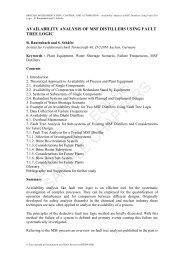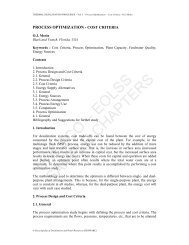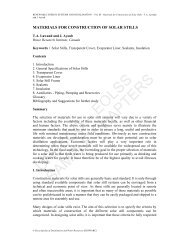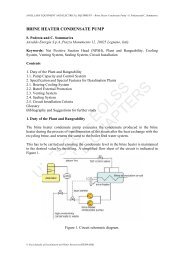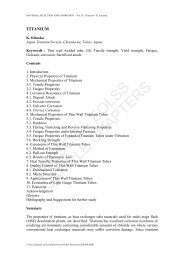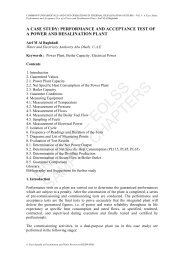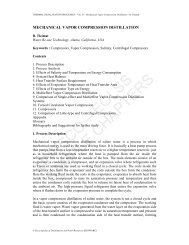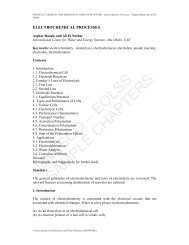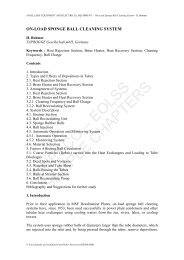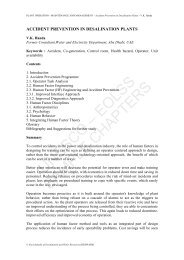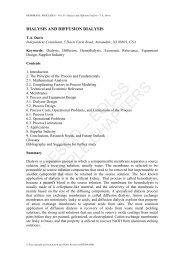Pressure Vessels and Piping Systems: Reliability, Risk and Safety ...
Pressure Vessels and Piping Systems: Reliability, Risk and Safety ...
Pressure Vessels and Piping Systems: Reliability, Risk and Safety ...
Create successful ePaper yourself
Turn your PDF publications into a flip-book with our unique Google optimized e-Paper software.
ANCILLARY EQUIPMENT AND ELECTRICAL EQUIPMENT - <strong>Pressure</strong> <strong>Vessels</strong> <strong>and</strong> <strong>Piping</strong> <strong>Systems</strong>: <strong>Reliability</strong>, <strong>Risk</strong> <strong>and</strong><br />
<strong>Safety</strong> Assessment - F.A. Simonen<br />
PRESSURE VESSELS AND PIPING SYSTEMS: RELIABILITY,<br />
RISK AND SAFETY ASSESSMENT<br />
F.A. Simonen<br />
Pacific Northwest National Laboratory, Richl<strong>and</strong>, Washington USA<br />
Keywords: <strong>Pressure</strong> vessel, piping, reliability, risk, probabilistic risk assessment,<br />
fracture mechanics.<br />
Contents<br />
1. Introduction<br />
2. Failure Mechanisms <strong>and</strong> Failure Modes<br />
2.1 Failure Modes<br />
2.2. Failure Mechanisms<br />
3. <strong>Reliability</strong> <strong>and</strong> <strong>Risk</strong><br />
4. Failure Frequency Estimation<br />
4.1. Advantages <strong>and</strong> Disadvantages of Alternative Methods<br />
5. Statistical Estimation Using Service Data<br />
6. Structural <strong>Reliability</strong> Models<br />
6.1. Reactor <strong>Pressure</strong> Vessel Codes<br />
6.2. <strong>Piping</strong> <strong>Reliability</strong> Codes<br />
7. Expert Judgment Elicitation<br />
8. Probabilistic <strong>Risk</strong> Assessment<br />
9. Role of Operation, Inspection <strong>and</strong> Maintenance<br />
10. <strong>Risk</strong>-Based In-service Inspection<br />
11. Probabilistic Design Methods<br />
12. Conclusion<br />
Glossary<br />
Bibliography <strong>and</strong> Suggestions for further study<br />
Biographical Sketch<br />
Summary<br />
UNESCO – EOLSS<br />
SAMPLE CHAPTERS<br />
<strong>Pressure</strong> vessels <strong>and</strong> piping systems are designed, fabricated, <strong>and</strong> operated to ensure<br />
very high levels of structural integrity, because the consequences of structural failures<br />
can be severe. Catastrophic ruptures can produce high-energy missiles, <strong>and</strong> cause<br />
damage to adjacent equipment <strong>and</strong> structures along with injuries <strong>and</strong> fatalities to<br />
workers <strong>and</strong> the public. Failure modes of a less catastrophic nature, such as leaks, can<br />
release hazardous <strong>and</strong> flammable materials that can also present significant hazards.<br />
While service experience over the last century shows an excellent record of reliability,<br />
efforts continue to improve <strong>and</strong> maintain the reliability of vessels <strong>and</strong> piping systems.<br />
This chapter describes methods to predict probabilities of failure <strong>and</strong> to quantify the<br />
consequences of such failures. These methods can be applied to vessels or piping<br />
systems taking into consideration component-specific design features, materials of<br />
construction, fabrication practices, operating stresses <strong>and</strong> temperatures, environmental<br />
factors, operating <strong>and</strong> maintenance practices, <strong>and</strong> in-service inspection programs.<br />
© Encyclopedia of Desalination <strong>and</strong> Water Resources (DESWARE)
ANCILLARY EQUIPMENT AND ELECTRICAL EQUIPMENT - <strong>Pressure</strong> <strong>Vessels</strong> <strong>and</strong> <strong>Piping</strong> <strong>Systems</strong>: <strong>Reliability</strong>, <strong>Risk</strong> <strong>and</strong><br />
<strong>Safety</strong> Assessment - F.A. Simonen<br />
Topics covered include: 1) probabilistic structural mechanics <strong>and</strong> fracture mechanics, 2)<br />
the role of probabilistic risk assessment evaluations, 3) application of failure event data<br />
from operating experience, 4) risk-informed in-service inspection, <strong>and</strong> 5) probabilistic<br />
design methods.<br />
1. Introduction<br />
The safety <strong>and</strong> reliability of pressure vessels <strong>and</strong> piping has been a public concern since<br />
the beginning of the industrial age. Failures of early steam boilers became widely<br />
reported as boiler explosions killed thous<strong>and</strong>s of people per year <strong>and</strong> inflicted great<br />
damage to property. As a result, engineering organizations <strong>and</strong> government agencies<br />
developed <strong>and</strong> imposed legal requirements for engineering codes that applied to the<br />
design, construction, <strong>and</strong> operation of boilers <strong>and</strong> other high pressure vessels. In the 50<br />
years after the American Society of Mechanical Engineering (ASME) was adopted, the<br />
number of deaths caused by explosions of properly operated boilers <strong>and</strong> pressure<br />
vessels was significantly reduced. Nevertheless, catastrophic failures still occur on rare<br />
occasions <strong>and</strong> other failures of a less significant nature (cracks <strong>and</strong> leaks) are more<br />
commonly reported. This chapter describes methods that can be used to estimate failure<br />
rates for vessels <strong>and</strong> piping systems. Also described are how such failure rates are used<br />
today in combination with evaluations of failure consequences using probabilistic risk<br />
assessment methods. Based on the author’s experience, the examples will focus on<br />
nuclear power plant applications. However, the same approaches also apply to other<br />
industries such as petro-chemical, gas transmission pipelines, <strong>and</strong> to more common<br />
items such as heating boilers <strong>and</strong> water heaters.<br />
<strong>Pressure</strong> vessels <strong>and</strong> piping systems are designed, fabricated, <strong>and</strong> operated to ensure a<br />
very high level of structural integrity because the consequences of structural failures can<br />
be severe. Even less catastrophic failures (such as leaks) can release hazardous <strong>and</strong><br />
flammable materials that present significant hazards. Despite excellent safety records<br />
ongoing efforts are needed to ensure that the reliability of vessels <strong>and</strong> piping systems<br />
are maintained. This chapter describes methods developed over recent decades to<br />
predict frequencies of failure <strong>and</strong> to quantify the consequences of failures. Such<br />
methods can take into account vessel-specific design features, materials, fabrication<br />
practices, operating stresses, operating temperatures, environmental factors, operating<br />
practices, <strong>and</strong> in-service inspection programs. Topics include: 1) probabilistic structural<br />
UNESCO – EOLSS<br />
SAMPLE CHAPTERS<br />
mechanics <strong>and</strong> fracture mechanics, 2) the role of probabilistic risk assessment, 3)<br />
application of failure event data from plant operating experience, 4) risk-informed inservice<br />
inspection, <strong>and</strong> 5) probabilistic design methods.<br />
2. Failure Mechanisms <strong>and</strong> Failure Modes<br />
Before the reliability of a vessel or piping system is evaluated, it is first necessary to<br />
identify the potential failure mechanisms <strong>and</strong> failure modes of concern. One must also<br />
relate different failure modes to possible safety <strong>and</strong>/or economic consequences.<br />
Judgment is needed to focus evaluations on those failure scenarios having highest<br />
likelihoods of occurrence.<br />
© Encyclopedia of Desalination <strong>and</strong> Water Resources (DESWARE)
ANCILLARY EQUIPMENT AND ELECTRICAL EQUIPMENT - <strong>Pressure</strong> <strong>Vessels</strong> <strong>and</strong> <strong>Piping</strong> <strong>Systems</strong>: <strong>Reliability</strong>, <strong>Risk</strong> <strong>and</strong><br />
<strong>Safety</strong> Assessment - F.A. Simonen<br />
2.1 Failure Modes<br />
There are many possible definitions (or degrees) of failure that may be of concern.<br />
Table 1 lists modes of failure that can be considered. These modes are presented in an<br />
increasing order of severity of consequence. The less severe modes (small cracks) are<br />
most likely to occur than the more severe modes (rupture). In addition, degradation if<br />
not detected <strong>and</strong> repaired will generally progress over time from a less severe mode<br />
(small crack) to more significant modes (leaking through-wall crack) <strong>and</strong> ultimately<br />
even to catastrophic failure.<br />
Small crack<br />
Local corrosion/wall thinning<br />
Excessive distortion<br />
Leaking Through-Wall Crack<br />
Through-wall corrosion/wall thinning<br />
Excessive Leakage<br />
Fracture/catastrophic rupture<br />
Table 1. Example Failure Modes<br />
In some cases, concerns may be limited to catastrophic ruptures that would present the<br />
greatest threat to workers or to the general public. In other cases, evaluations may have<br />
a broader objective that considers unexpected degradation (corrosion, cracking, etc.)<br />
that would require repairs or replacements of components <strong>and</strong> thereby have an<br />
economic impact associated with repair costs <strong>and</strong>/or the loss of the productive use of the<br />
component. The consequences of small leaks can be very different depending on the<br />
situation. For a water storage vessel, the loss of a small volume of water could be of<br />
little concern; whereas, small leaks in vessels containing toxic or flammable materials<br />
could result in a large number of fatalities.<br />
Table 1 lists failure modes in order of increasing consequences as follows:<br />
• Small Crack – Degradation is sometimes detected in the form of a crack that does not<br />
fully penetrate the wall of the vessel or piping component. While such structural<br />
degradation by itself may pose no immediate safety consequences, it is prudent to<br />
take corrective actions to prevent future consequences. The need for repairs to the<br />
degraded component should be determined <strong>and</strong> implications for other similar<br />
components should be evaluated. Corrective actions could include an aggressive<br />
inspection program. In some cases, complete replacement of piping <strong>and</strong> vessels may<br />
be needed if the original designs <strong>and</strong> the selected materials are determined to be<br />
unsuitable for the operating conditions at the facility.<br />
• Local Corrosion <strong>and</strong> Wall Thinning – While design methods usually specify a wall<br />
thickness that includes some allowance for corrosion over the life of the vessel <strong>and</strong><br />
piping, the actual operating conditions may produce local rates of corrosion that<br />
exceed the expected rates. Inspections can <strong>and</strong> should detect corrosion before it fully<br />
penetrates the wall thickness <strong>and</strong> before any safety impacts result. As in the case of<br />
UNESCO – EOLSS<br />
SAMPLE CHAPTERS<br />
© Encyclopedia of Desalination <strong>and</strong> Water Resources (DESWARE)
ANCILLARY EQUIPMENT AND ELECTRICAL EQUIPMENT - <strong>Pressure</strong> <strong>Vessels</strong> <strong>and</strong> <strong>Piping</strong> <strong>Systems</strong>: <strong>Reliability</strong>, <strong>Risk</strong> <strong>and</strong><br />
<strong>Safety</strong> Assessment - F.A. Simonen<br />
cracking, corrective measures in the form of repairs <strong>and</strong> additional inspections<br />
should be implemented to ensure safe <strong>and</strong> economical operation.<br />
• Excessive Distortion – A failure mode of concern may not involve penetration of the<br />
component wall, but may rather degrade the function of the component because of<br />
excessive deflection or distortion. For example, seating surfaces may become<br />
sufficiently misaligned to the degree that gasket leakage results.<br />
• Leaking Through-Wall Crack – In some cases, even a small amount of leakage can<br />
have significant safety consequences, especially if the leaking fluid is highly toxic or<br />
flammable. In other cases, the release of otherwise non-hazardous fluids could<br />
impact the operation of nearby critical equipment by causing corrosion or electrical<br />
malfunctions.<br />
• Through-Wall Corrosion/Wall Thinning – As for cracking, leakage even at relatively<br />
small rates can present significant safety or economic consequences.<br />
• Excessive Leakage – Leakage rates can over time increase to levels that impact the<br />
function of a system or component. For example, a leak could eventually<br />
depressurize a critical system to the extent that it could no longer perform its<br />
intended function. In other cases, the leakage could create a water spray that could<br />
cause damage in the area adjacent to the leak.<br />
• Fracture/Catastrophic Rupture – This most severe of consequences comes from<br />
sudden fracture or ruptures, which can occur without any prior leakage to give any<br />
warning of impending failure. The consequences of concern can be related to loss of<br />
function of the rupture component itself (e.g., loss of cooling water to process<br />
equipment) or can come from the extreme energy of the rupture event (e.g., high<br />
velocity missiles, blast waves, release of hot fluids, etc.).<br />
UNESCO – EOLSS<br />
SAMPLE CHAPTERS<br />
Figure 1. Pipe that ruptured at nuclear power plant after severe wall thinning at inner<br />
surface caused by flow-assisted corrosion.<br />
Figures 1–3 show some examples of ruptured piping. In each case, the failure involved<br />
the release of large amounts of energy along with significant economic impacts in terms<br />
of repair costs <strong>and</strong> shutdowns of important industrial facilities for extended periods of<br />
time. Figure 1 illustrates a failure associated with severe thinning of the pipe wall that<br />
caused a pipe rupture <strong>and</strong> fatalities to workers at a nuclear power plant. Figure 2 shows<br />
a ruptured pipe that had been in service for a large number of years. In this case, the<br />
corrosion damage to the older pipe was relatively small with the primary cause of<br />
failure being a sudden over-pressure from a water hammer event. Figure 3 shows<br />
© Encyclopedia of Desalination <strong>and</strong> Water Resources (DESWARE)
ANCILLARY EQUIPMENT AND ELECTRICAL EQUIPMENT - <strong>Pressure</strong> <strong>Vessels</strong> <strong>and</strong> <strong>Piping</strong> <strong>Systems</strong>: <strong>Reliability</strong>, <strong>Risk</strong> <strong>and</strong><br />
<strong>Safety</strong> Assessment - F.A. Simonen<br />
another ruptured pipe that failed at a coal-fired power plant. In this case, the degradation<br />
was not wall thinning but cracking by the mechanism of creep damage to an axial weld<br />
in the pipe that operated at a relatively high temperature. The catastrophic nature of the<br />
failures shown by Figures 1–3 serve to emphasize hazards associated with operation of<br />
pressure vessels <strong>and</strong> piping <strong>and</strong> the need to reduce failure frequencies to the lowest<br />
possible levels.<br />
Figure 2. Steam pipe at municipal heating system that ruptured because of severe load<br />
imposed by water hammer event.<br />
UNESCO – EOLSS<br />
SAMPLE CHAPTERS<br />
Figure 3. Pipe at coal-fired power plant that ruptured along axial weld because of high<br />
© Encyclopedia of Desalination <strong>and</strong> Water Resources (DESWARE)
ANCILLARY EQUIPMENT AND ELECTRICAL EQUIPMENT - <strong>Pressure</strong> <strong>Vessels</strong> <strong>and</strong> <strong>Piping</strong> <strong>Systems</strong>: <strong>Reliability</strong>, <strong>Risk</strong> <strong>and</strong><br />
<strong>Safety</strong> Assessment - F.A. Simonen<br />
2.2. Failure Mechanisms<br />
temperature creep damage to weld.<br />
Table 2 lists a number of failure mechanisms <strong>and</strong> other causes that are known to result<br />
in failures of pressure vessels <strong>and</strong> piping systems. This list is intended only to show<br />
examples <strong>and</strong> will not be discussed in detail. Many failures come from gradual material<br />
degradation (e.g., corrosion, fatigue cracking, wear, etc.) that occurs over time spans of<br />
many years before it advances to a stage sufficient to cause a structural failure (leak or<br />
rupture event). Metal fatigue is one common failure mechanism. Small-diameter piping<br />
is often subject to vibrational stresses that cause cracking. Fatigue failures of larger<br />
sizes of vessels <strong>and</strong> piping are more likely to come from cyclic thermal stresses such as<br />
at locations exposed to cyclic exposures to hot <strong>and</strong> cold fluids. Corrosion mechanisms<br />
are a particularly common cause of failures both in the form of widespread loss material<br />
(wall thinning) or as local attack such as pitting or cracking.<br />
In other cases, a single short-term event (e.g., overpressure, extreme overheating, water<br />
hammer, etc.) can cause a sudden failure. Some loading events are natural occurrences<br />
such as earthquake loadings; whereas, other events come from human errors in<br />
operating <strong>and</strong> maintaining the facility such as from improper repairs <strong>and</strong> operation at<br />
pressures or temperatures over design limits. Pressurized systems are usually protected<br />
from excess pressures <strong>and</strong> temperatures by safety devices, but these devices can fail to<br />
function due to time-related degradation or improper installation or maintenance.<br />
Operation at loads <strong>and</strong>/or pressures exceeding design limits<br />
Operation at temperatures over design limits<br />
Operation at temperatures below brittle fracture limits<br />
Improper design <strong>and</strong> fabrication<br />
Improper repairs <strong>and</strong> alterations<br />
Structural damage from maintenance<br />
Improper or degraded supports for components<br />
Structural damage from external events (impact, crushing, etc.)<br />
Excessive vibration<br />
Improper or degraded overpressure protection<br />
Material or welding defects<br />
General corrosion<br />
Flow-assisted corrosion<br />
Wear (excessive maintenance)<br />
Thermal fatigue cracking<br />
Vibration fatigue cracking<br />
Stress corrosion cracking<br />
High-temperature creep<br />
Long-term embrittlement<br />
Loose or missing fasteners<br />
UNESCO – EOLSS<br />
SAMPLE CHAPTERS<br />
© Encyclopedia of Desalination <strong>and</strong> Water Resources (DESWARE)
ANCILLARY EQUIPMENT AND ELECTRICAL EQUIPMENT - <strong>Pressure</strong> <strong>Vessels</strong> <strong>and</strong> <strong>Piping</strong> <strong>Systems</strong>: <strong>Reliability</strong>, <strong>Risk</strong> <strong>and</strong><br />
<strong>Safety</strong> Assessment - F.A. Simonen<br />
3. <strong>Reliability</strong> <strong>and</strong> <strong>Risk</strong><br />
Table 2. Example Failure Causes<br />
Terms related to reliability <strong>and</strong> risk must be clearly defined <strong>and</strong> understood within the<br />
context of vessel <strong>and</strong> piping integrity. <strong>Risk</strong> combines the concepts of probability of<br />
failure <strong>and</strong> consequences of failure using the definition<br />
<strong>Risk</strong> = Probability of Failure × Consequences of Failure<br />
Probability is usually quantified as a failure frequency, which expresses the number of<br />
failure events that occur over a given time span. It is important to define the event of<br />
concern along with the time span of interest. An example definition would be rupture<br />
events per vessel per year of operation. Another example related to piping systems<br />
would be leaks per weld per year or leaks per meter of pipe per year. In other cases, it<br />
may be of interest to address reliability in a larger context such as failures per plant or<br />
failures per system.<br />
The concept of failure frequency is applied to systems that operate on a continuing<br />
basis, as for example at electric power plants. However, other systems remain in a<br />
st<strong>and</strong>by mode during normal operation <strong>and</strong> are needed only rarely to perform critical<br />
functions in times of emergencies. An example would be piping in a fire protection<br />
system. For such systems, risk evaluations express reliability in terms of probability of<br />
failure per dem<strong>and</strong> rather than as failures per year.<br />
Different failure events can have wide ranging consequences. Consequences can only<br />
be of an economic nature expressed in terms of dollars associated with loss of<br />
production plus the labor <strong>and</strong> materials for repairs. There can also be safety<br />
consequences from injuries to workers <strong>and</strong>/or the general public. For example, a small<br />
leak at a power plant would have no safety consequences <strong>and</strong> only minor economic<br />
consequences if the repair of the leak can be accomplished without interrupting the<br />
operation of the plant. On the other h<strong>and</strong>, the rupture of a pressure vessel or a large pipe<br />
could cause a large energy release, an explosion, or a fire with human deaths <strong>and</strong><br />
injuries. In addition to severe safety consequences, ruptures can have major economic<br />
consequences totaling millions of dollars both from an extended shut down of a large<br />
production facility <strong>and</strong> major costs to replace the ruptured component along with repairs<br />
UNESCO – EOLSS<br />
SAMPLE CHAPTERS<br />
to damage inflicted on adjacent components <strong>and</strong> structures.<br />
4. Failure Frequency Estimation<br />
Failure frequencies for pressure boundary components must often be estimated to<br />
support Probabilistic <strong>Risk</strong> Assessments (PRAs) <strong>and</strong> other decision making purposes.<br />
Estimates are most often based on reported failures from past service experience <strong>and</strong><br />
have focused on a system level rather than on the component level. Such estimates have<br />
limitations for predicting future performance <strong>and</strong> in identifying priorities for managing<br />
the integrity of specific components. Estimates based on service experience are better<br />
for evaluations of more common failure modes consisting of small leaks. Estimates for<br />
the frequencies of larger leaks <strong>and</strong> rupture events are, however, subject to larger<br />
© Encyclopedia of Desalination <strong>and</strong> Water Resources (DESWARE)
ANCILLARY EQUIPMENT AND ELECTRICAL EQUIPMENT - <strong>Pressure</strong> <strong>Vessels</strong> <strong>and</strong> <strong>Piping</strong> <strong>Systems</strong>: <strong>Reliability</strong>, <strong>Risk</strong> <strong>and</strong><br />
<strong>Safety</strong> Assessment - F.A. Simonen<br />
uncertainties if based soley on service experience.<br />
<strong>Risk</strong> evaluations require realistic estimates of failure frequencies that apply to the<br />
specific combinations of materials, degradation mechanisms, <strong>and</strong> operating conditions.<br />
There are four basic approaches discussed below for estimating piping <strong>and</strong> vessel<br />
reliability:<br />
(1) Statistical estimation using service data,<br />
(2) Structural reliability analysis (SRA) based on probabilistic fracture mechanics,<br />
(3) Expert judgment/expert elicitation, <strong>and</strong><br />
(4) Any combination of (1) through (3).<br />
-<br />
-<br />
-<br />
TO ACCESS ALL THE 26 PAGES OF THIS CHAPTER,<br />
Visit: http://www.desware.net/DESWARE-SampleAllChapter.aspx<br />
Bibliography <strong>and</strong> Suggestions for further study<br />
ASME (2002). St<strong>and</strong>ard for Probabilistic <strong>Risk</strong> Assessment for Nuclear Power Plant Applications, ASME<br />
RA-S-2002, American Society of Mechanical Engineers, New York. [Specifies the minimum<br />
requirements for a PRA that is used for a specific decision making application].<br />
Balkey K.R. <strong>and</strong> FA Simonen (1999). <strong>Risk</strong>-Based Inspection Guidelines for Nuclear Power Plant<br />
Components, Transactions of the 11th International Conference on Structural Mechanics in Reactor<br />
Technology, Berlin, Germany: International Association for Structural Mechanics in Reactor Technology.<br />
[Describes the technical basis for the risk-informed inspection requirements that were later adopted by<br />
the ASME Section XI Code].<br />
Bell C.D. <strong>and</strong> O.J.V. Chapman. (2003). Description of PRODIGAL, NURBIM Report D4/Appendix F,<br />
Rolls-Royce plc. [A probabilistic fracture mechanics code for welds in vessels <strong>and</strong> piping that was<br />
developed in the United Kingdom for naval reactor applications].<br />
UNESCO – EOLSS<br />
SAMPLE CHAPTERS<br />
Bernsen S.A., F.A. Simonen <strong>and</strong> K.R. Balkey (2006). PRA <strong>and</strong> <strong>Risk</strong>-Informed Analysis, Chapter 45<br />
Companion Guide to the ASME Boiler <strong>and</strong> <strong>Pressure</strong> Vessel Codes – Second Edition – Volume 3, ASME<br />
Press, New York, USA. [One of many chapters in a set of volumes that explains in the technical basis <strong>and</strong><br />
provides guidance for users of ASME Code.]<br />
Bishop B.A. (1993) Benchmarking of Probabilistic Fracture Mechanics Analyses of Reactor <strong>Vessels</strong><br />
Subjected to Pressurized Thermal Shock Loading, EPRI Research Project 2975-5, Electric Power<br />
Research Institute, Palo Alto, CA. [Presents results of calculations performed to compare numerical<br />
results from several probabilistic fracture mechanics computer codes for a set of well defined example<br />
problems].<br />
Bishop B.A. (1997). An Updated Structural <strong>Reliability</strong> Model for <strong>Piping</strong> <strong>Risk</strong> Informed ISI, PVP-Vol.<br />
346, Fatigue <strong>and</strong> Fracture - 1997, Volume 2, American Society of Mechanical Engineers, New York.<br />
[Describes the development of the SRRA probabilistic fracture mechanics code].<br />
Brickstad B. <strong>and</strong> W. Zang. (2001). NURBIT Nuclear RBI Analysis Tool, A Software for <strong>Risk</strong><br />
Management of Nuclear Components, Technical Report No 10334900-1, DNV, Stockholm, Sweden. [A<br />
© Encyclopedia of Desalination <strong>and</strong> Water Resources (DESWARE)
ANCILLARY EQUIPMENT AND ELECTRICAL EQUIPMENT - <strong>Pressure</strong> <strong>Vessels</strong> <strong>and</strong> <strong>Piping</strong> <strong>Systems</strong>: <strong>Reliability</strong>, <strong>Risk</strong> <strong>and</strong><br />
<strong>Safety</strong> Assessment - F.A. Simonen<br />
probabilistic fracture mechanics code for pressure vessels <strong>and</strong> piping that was developed in Sweden for<br />
commercial power plant applications].<br />
Brickstad B., O.J.V. Chapman, T. Schimpfke, H. Schulz, <strong>and</strong> A. Muhammed. (2004). Review <strong>and</strong><br />
Benchmarking of SRM <strong>and</strong> Associated Software, NURBIM Final Report D4, Contract FIKS-CT-2001-<br />
00172, DNV, Stockholm. [Presents results of comparison calculations using several probabilistic fracture<br />
mechanic computer codes that serve to demonstrate different features of the codes].<br />
Cheverton R.D. <strong>and</strong> D.G. Ball. (1984). OCA-P: A Deterministic <strong>and</strong> Probabilistic Fracture-Mechanics<br />
Code for Applications to <strong>Pressure</strong> <strong>Vessels</strong>, NUREG/CR-3618, prepared by Oak Ridge National<br />
Laboratory for the U.S. Nuclear Regulatory Commission. [The first probabilistic fracture mechanics code<br />
developed to calculate failure probabilities for reactor pressure vessels].<br />
Dickson T.L. (1994). FAVOR: A Fracture Mechanics Analysis Code for Nuclear Reactor <strong>Pressure</strong><br />
Vessel, Release 9401, ORNL/NRC/LTR/94/1. Martin Marietta Energy <strong>Systems</strong>, Inc., Oak Ridge National<br />
Laboratory. [Describes the development of a probabilistic fracture mechanics code for calculating failure<br />
probabilities for reactor pressure vessels].<br />
Dickson T.L., P.T. Williams <strong>and</strong> S Yin. (2004). Fracture Analysis of <strong>Vessels</strong> – Oak Ridge, FAVOR,<br />
v04.1, Computer Code: User’s Guide, NUREG/CR-6855, ORNL/TM-2004/245, October 2004. [The<br />
latest probabilistic fracture mechanics code developed to calculate failure probabilities for reactor<br />
pressure vessels].<br />
Dillstrom P. (2003). A Short Description of ProSACC, NURBIM Report D4/Appendix G, DNV,<br />
Stockholm. [A probabilistic fracture mechanics code for pressure vessels <strong>and</strong> piping that was developed<br />
in Sweden for commercial power plant applications].<br />
Gosselin S.R., F.A. Simonen, R.G. Carter, J.M. Davis <strong>and</strong> G.L. Stevens. (2005). Enhanced ASME<br />
Section XI Appendix L Flaw Tolerance Procedure, PVP2005-71100, Proceedings of the 2005 ASME<br />
<strong>Pressure</strong> <strong>Vessels</strong> <strong>and</strong> <strong>Piping</strong> Conference, July 17-21, 2005, Denver, Colorado. [Describes a method for<br />
predicting fatigue life based on damage tolerance approach that has been adopted by the ASME Section<br />
III Code].<br />
Harris D.O., E.Y. Lim <strong>and</strong> D.D. Dedhia. (1981). Probability of Pipe Fracture in the Primary Coolant<br />
Loop of a PWR Plant Volume 5: Probabilistic Fracture Mechanics Analysis - Load Combination<br />
Program Project 1 Final Report, NUREG/CR-2189, Vol. 5, prepared by Lawrence Livermore National<br />
Laboratory for the U.S. Nuclear Regulatory Commission, Washington, DC. [The technical basis<br />
document for the PRAISE code that predicts leak <strong>and</strong> rupture probabilities for piping welds subject to<br />
fatigue cycles <strong>and</strong> seismic loads].<br />
Harris D.O., D.D. Dedhia, E.D. Eason <strong>and</strong> S.D. Patterson. (1986). Probability of Failure in BWR Reactor<br />
Coolant <strong>Piping</strong>: Probabilistic Treatment of Stress Corrosion Cracking in 304 <strong>and</strong> 316NG BWR <strong>Piping</strong><br />
Weldments, NUREG/CR-4792 v3, U.S. Nuclear Regulatory Commission, Washington, DC. [The<br />
technical basis document for an improved version of the PRAISE code that predicts failure probabilities<br />
for piping welds subject to stress corrosion cracking].<br />
Harris D.O. <strong>and</strong> D.D. Dedhia. (1992). Theoretical <strong>and</strong> User’s Manual for pc-PRAISE, A Probabilistic<br />
Fracture Mechanics Computer Code for <strong>Piping</strong> <strong>Reliability</strong> Analysis, NUREG/CR-5864, U.S. Nuclear<br />
Regulatory Commission, Washington, DC. [A version of mainframe PRAISE code that was adapted for<br />
use on personal computers.]<br />
Harris D.O. <strong>and</strong> D.D. Dedhia. (1998). WinPRAISE 98 PRAISE Code in Windows, April 1998. [A version<br />
of the PRAISE code that allows for interactive entries of input data].<br />
Khaleel M.A. <strong>and</strong> F.A. Simonen. (1994a). The Effects of Initial Flaw Sizes <strong>and</strong> In-service Inspection on<br />
<strong>Piping</strong> <strong>Reliability</strong>, ASME PVP Vol. 288, Service Experience <strong>and</strong> <strong>Reliability</strong> Improvement: Nuclear,<br />
Fossil <strong>and</strong> Petrochemical Plants, Vol. 1, pp. 95-107. [Application of the PRAISE code to show how<br />
probability of detection <strong>and</strong> frequencies of inspections can reduce failure probabilities of piping welds].<br />
UNESCO – EOLSS<br />
SAMPLE CHAPTERS<br />
Khaleel M.A. <strong>and</strong> F.A. Simonen. (1994b). A Parametric Approach to Predicting the Effects of Fatigue on<br />
<strong>Piping</strong> <strong>Reliability</strong>, ASME PVP Vol. 288, Service Experience <strong>and</strong> <strong>Reliability</strong> Improvement: Nuclear,<br />
Fossil <strong>and</strong> Petrochemical Plants, Vol. 1, pp. 117-125. [Application of the PRAISE code to show how the<br />
magnitude <strong>and</strong> frequency of fatigue stresses related to failure probabilities of piping welds].<br />
© Encyclopedia of Desalination <strong>and</strong> Water Resources (DESWARE)
ANCILLARY EQUIPMENT AND ELECTRICAL EQUIPMENT - <strong>Pressure</strong> <strong>Vessels</strong> <strong>and</strong> <strong>Piping</strong> <strong>Systems</strong>: <strong>Reliability</strong>, <strong>Risk</strong> <strong>and</strong><br />
<strong>Safety</strong> Assessment - F.A. Simonen<br />
Khaleel M.A., F.A. Simonen, D.O. Harris <strong>and</strong> D. Dedhia. (1995). The Impact of Inspection on<br />
Intergranular Stress Corrosion Cracking for Stainless Steel <strong>Piping</strong>, ASME PVP Vol. 266/SERA-Vol.3,<br />
<strong>Risk</strong> <strong>and</strong> <strong>Safety</strong> Assessment: Where is the Balance, pp. 411-422. [Application of the PRAISE code to<br />
show how probability of detection <strong>and</strong> frequencies of inspections can reduce failure probabilities of<br />
piping welds subject to stress corrosion cracking].<br />
Khaleel M.A. <strong>and</strong> F.A. Simonen. (2000a). Effects of Alternative Inspection Strategies on <strong>Piping</strong><br />
<strong>Reliability</strong>, Nuclear Engineering <strong>and</strong> Design, Vol. 197, pp. 115-140. [Application of the PRAISE code to<br />
show how probability of detection <strong>and</strong> frequencies of inspections can reduce failure probabilities of<br />
piping welds].<br />
Khaleel M.A., F.A. Simonen, H.K. Phan, D.O. Harris, <strong>and</strong> D.D. Dedhia. (2000b). Fatigue Analysis of<br />
Components for 60-Year Plant Life, NUREG/CR-6674, PNNL-13227, prepared by Pacific Northwest<br />
National Laboratory for U.S. Nuclear Regulatory Commission, Washington, DC. [Application of the<br />
PRAISE code to compare failure probabilities at 40 <strong>and</strong> 60 years of plant operation for piping subject to<br />
fatigue cycling].<br />
Lydell B.O.Y., E. Mathet <strong>and</strong> K. Gott. (2004). <strong>Piping</strong> Service Life Experience in Commercial Nuclear<br />
Power Plants: Progress with the OECD Pipe Failure Data Exchange Project, Proceedings. of the 2004<br />
ASME <strong>Pressure</strong> <strong>Vessels</strong> <strong>and</strong> <strong>Piping</strong> Conference, American Society of Mechanical Engineers, New York).<br />
[A discussion of a data base on piping failures reported a commercial nuclear power plants].<br />
Lydell B.O.Y. <strong>and</strong> A. Olsson. (2006). <strong>Reliability</strong> Data for <strong>Piping</strong> Components in Nordic Nuclear Power<br />
Plants, 2005153-M-003 Rev. A1, Relcon AB, Malmö ,Sweden, March 2, 2006. [A discussion of a data<br />
base on piping failures reported a commercial nuclear power plants].<br />
Mohammed A.A. (2003). A Short Description of STRUEL, NURBIM Report D4/Appendix H, TWI. [A<br />
probabilistic fracture mechanics code for welds in vessels <strong>and</strong> piping that was developed in Germany].<br />
Mosleh A. et al. (1987). Methods for Elicitation <strong>and</strong> Use of Expert Opinion in <strong>Risk</strong> Assessment,<br />
NUREG/CR-4962, U.S. Nuclear Regulatory Commission, Washington, DC. [A h<strong>and</strong>book type of<br />
document to guide the application of expert judgment to nuclear power plant applications.]<br />
NASA. (2002). Probabilistic <strong>Risk</strong> Assessment Procedures <strong>and</strong> Guide for NASA Managers <strong>and</strong><br />
Practitioners, version 1.1, prepared for Office of <strong>Safety</strong> <strong>and</strong> Mission Assurance, National Aeronautics<br />
<strong>and</strong> Space Administration Headquarters, Washington, DC, USA. [This 323 page instructional document<br />
is available to the public through the internet from the website<br />
www.hq.nasa.gov/office/codeq/doctree/praguide.pdf].<br />
NRC. (1975). Reactor <strong>Safety</strong> Study: An Assessment of Accident <strong>Risk</strong>s at U.S. Commercial Nuclear Power<br />
Plants, Technical Report WASH-1400, U.S. Nuclear Regulatory Commission, Washington, DC. [A<br />
l<strong>and</strong>mark study that was used to evaluate the public risk from commercial nuclear power plants].<br />
NRC. (1983). PRA Procedures Guideline: A Guide to the Performance of Probabilistic <strong>Risk</strong> Assessment<br />
for nuclear Power Plants. NUREG/CR-2300. Washington D.C. Nuclear Regulatory Commission. [A<br />
document prepared by the USNRC to provide guidance to the nuclear power industry for developing a<br />
plant specific PRA].<br />
NRC. (1990). Severe Accident <strong>Risk</strong>s: An Assessment of Five U.S. Nuclear Power Plants, NUREG-1150,<br />
U.S. Nuclear Regulatory Commission, Washington, DC. [A major study supported by the USNRC to<br />
demonstrate the use of PRA methods to a representative sample of commercial nuclear power plants].<br />
NRC. (1991). Requirements for Monitoring the Effectiveness of Maintenance at Nuclear Power Plants,<br />
10 CFR 50.65. U.S. Nuclear Regulatory Commission, Washington DC. [A regulatory document that<br />
requires commercial nuclear power plant to apply insights from risk calculations to guide the<br />
maintenance of nuclear power plants].<br />
UNESCO – EOLSS<br />
SAMPLE CHAPTERS<br />
OECD Nuclear Energy Agency. (2005). OECD-NEA <strong>Piping</strong> Failure Data Exchange Project (OPDE),<br />
Workshop on Database Applications, OPDE/SEC(2004)4, Issy-les-Moulineaux, France. [A discussion of<br />
a data base on piping failures reported a commercial nuclear power plants].<br />
© Encyclopedia of Desalination <strong>and</strong> Water Resources (DESWARE)
ANCILLARY EQUIPMENT AND ELECTRICAL EQUIPMENT - <strong>Pressure</strong> <strong>Vessels</strong> <strong>and</strong> <strong>Piping</strong> <strong>Systems</strong>: <strong>Reliability</strong>, <strong>Risk</strong> <strong>and</strong><br />
<strong>Safety</strong> Assessment - F.A. Simonen<br />
OECD Nuclear Energy Agency. (2006). OPDE 2006:1 Coding Guideline (OPDE-CG) & OPDE User<br />
Instruction, PR01 Version 02, Issy-les-Moulineaux (France). [Guidance on the use of a data base on<br />
piping failures reported a commercial nuclear power plants].<br />
Poloski J.P., D.G. Marksberry, C.L. Atwood <strong>and</strong> W.J. Galyean. (1999). Rates of Initiating Events at U.S.<br />
Nuclear Power Plants: 1987-1995, NUREG/CR-5750, prepared by Idaho National Engineering<br />
Laboratory for U.S. Nuclear Regulatory Commission, Washington, DC. [A compilation <strong>and</strong> evaluation of<br />
reported events at commercial nuclear power plants including failures by leakage <strong>and</strong> rupture of piping].<br />
Rudl<strong>and</strong> D.L. H. Xu, G. Wilkowski, P. Scott, N. Ghadiali <strong>and</strong> F. Brust. (2006a). Development of a New<br />
Generation Computer Code (PRO-LOCA) for the Prediction of Break Probabilities for Commercial<br />
Nuclear Power Plants Loss-of-Coolant Accidents, Proceeding of the ASME <strong>Pressure</strong> <strong>Vessels</strong> <strong>and</strong> <strong>Piping</strong><br />
Conference, July 23-27, 2006, Vancouver, British Columbia, American Society of Mechanical Engineers,<br />
New York, New York. [A paper on the early development of the PRO-LOCA probabilistic fracture<br />
mechanics codes for calculating failure frequencies for piping at commercial nuclear power plants].<br />
Schimpfke T. (2003). A Short Description of the <strong>Piping</strong> <strong>Reliability</strong> Code PROST, NURBIM Report<br />
D4/Appendix C, GRS. [A probabilistic fracture mechanics code for welds in piping that was developed in<br />
Germany].<br />
Simonen F.A., K.I. Johnson, A.M. Liebetrau, D.W. Engel <strong>and</strong> E.P. Simonen. (1986). VISA-II - A<br />
Computer Code for Predicting the Probability of Reactor <strong>Pressure</strong> Vessel Failure, NUREG/CR-4486,<br />
prepared by Pacific Northwest National Laboratory for the U.S. Nuclear Regulatory Commission. [A<br />
probabilistic fracture mechanics code developed by the USNRC to calculate failure probabilities for<br />
reactor pressure vessels].<br />
Simonen F.A., D.O. Harris <strong>and</strong> D.D. Dedhia. (1998). Effect of Leak Detection on <strong>Piping</strong> Failure<br />
Probabilities, Fatigue Fracture <strong>and</strong> Residual Stress, ASME PVP-Vol. 373, pp. 105-113. [Application of<br />
the PRAISE code to show how leak detection can reduce failure probabilities of piping welds].<br />
Simonen F.A. <strong>and</strong> M.A. Khaleel. (1998a). On the Contribution of Buried Flaws to <strong>Piping</strong> Failure<br />
Probabilities, Fatigue Fracture <strong>and</strong> Residual Stress, ASME PVP-Vol. 373, pp. 69-75. [Application of the<br />
PRAISE code that compares the contributions to piping failure probabilities from inner surface flaws to<br />
the contributions from subsurface buried flaws].<br />
Simonen F.A. <strong>and</strong> M.A. Khaleel. (1998b). Effects of Flaw Sizing Errors on the <strong>Reliability</strong> of <strong>Vessels</strong> <strong>and</strong><br />
<strong>Piping</strong>, ASME Journal of <strong>Pressure</strong> Vessel Technology, Vol. 120, pp. 365-373. [Application of the<br />
PRAISE code that shows that flaw sizing errors is not as important to piping reliability as the failure to<br />
detect flaws].<br />
Tregoning R., L. Abramson <strong>and</strong> P. Scott. (2005). Estimating Loss-of-Coolant-Accident (LOCA)<br />
Frequencies Through the Elicitation Process, NUREG-1829 (June 30, 2005), U.S. Nuclear Regulatory<br />
Commission, Washington, DC. [A large-scale effort to apply current knowledge to estimate piping failure<br />
frequencies that used an international panel of experts].<br />
UNESCO – EOLSS<br />
SAMPLE CHAPTERS<br />
Westinghouse Owners Group (1997). Application of <strong>Risk</strong>-Informed Methods to <strong>Piping</strong> In-service<br />
Inspection, Topical Report, WCAP-14572, Rev. 1 Westinghouse Energy <strong>Systems</strong>. [A trial application of<br />
the risk-based based methods for in-service inspection of piping systems developed for the ASME<br />
Section XI Code].<br />
Biographical Sketch<br />
Fredric Simonen, a mechanical engineer, graduated in 1966 with a Ph.D. degree in Engineering<br />
Mechanics from Stanford University located at Stanford, California, USA. He is presently a Laboratory<br />
Fellow (retired) in the Computational Mechanics Group at Pacific Northwest National Laboratory in<br />
Richl<strong>and</strong>, Washington, USA. Since joining the Pacific Northwest National Laboratory in 1976, <strong>and</strong><br />
before that at the Battelle Columbus Division beginning in 1966, Dr. Simonen has worked in the areas of<br />
fracture mechanics <strong>and</strong> structural integrity. His research has addressed the safety <strong>and</strong> reliability of nuclear<br />
pressure vessels <strong>and</strong> piping as well as other industrial <strong>and</strong> aerospace structures <strong>and</strong> components. Since the<br />
early 1980s, he has lead several studies for the U.S. Nuclear Regulatory Commission of the effects of<br />
pressurized thermal shock on the failure probability of reactor pressure vessels. This work has advanced<br />
© Encyclopedia of Desalination <strong>and</strong> Water Resources (DESWARE)
ANCILLARY EQUIPMENT AND ELECTRICAL EQUIPMENT - <strong>Pressure</strong> <strong>Vessels</strong> <strong>and</strong> <strong>Piping</strong> <strong>Systems</strong>: <strong>Reliability</strong>, <strong>Risk</strong> <strong>and</strong><br />
<strong>Safety</strong> Assessment - F.A. Simonen<br />
the technology of probabilistic fracture mechanics <strong>and</strong> methods for estimating the number <strong>and</strong> sizes of<br />
flaws in vessel welds. During the 1990s, Dr. Simonen was a leader on the behalf of NRC <strong>and</strong> the<br />
American Society of Mechanical Engineers in the implementation of risk-informed methods for the<br />
inspection of nuclear piping systems. He has published over 200 papers, articles, <strong>and</strong> reports in the open<br />
literature. Dr. Simonen is a member of the American Society of Mechanical Engineers <strong>and</strong> has served on<br />
numerous ASME committees <strong>and</strong> codes <strong>and</strong> st<strong>and</strong>ards bodies.<br />
UNESCO – EOLSS<br />
SAMPLE CHAPTERS<br />
© Encyclopedia of Desalination <strong>and</strong> Water Resources (DESWARE)



